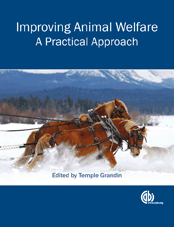 |
Improving Animal Welfare: A Practical ApproachEdited by Dr. Temple GrandinColorado State University, USA
ISBN: 978-1-84593-541-2
Subject Classifcation: KNAC, PSVP, TVH, TW
Links for ordering: |
 |
Improving Animal Welfare: A Practical ApproachEdited by Dr. Temple GrandinColorado State University, USA
ISBN: 978-1-84593-541-2
Subject Classifcation: KNAC, PSVP, TVH, TW
Links for ordering: |
This chapter contains practical instructions for correct stunning procedures and outlines an objective numerical scoring system for evaluating animal welfare in slaughter plants. The species that are covered are cattle, pigs, sheep, fish, and poultry. The following critical control points should be numerically scored:
There are 8 diagrams and photos to assist the reader in determining insensibility, showing the correct electric stunner placement , and using the right equipment for moving non-ambulatory animals.
Chapter 10 has diagrams for correct captive bolt or gunshot placement.
Below is an excerpt from Chapter 9...
There are four basic types of problems that cause poor animal welfare in a slaughter plant, and to be effective in solving problems that cause animal suffering one must correctly determine the cause of the problem. The four basic types of problems are:
Some of the most serious animal welfare problems exist in parts of the world where modern equipment for handling and restraining large animals such as cattle or water buffalos is not available. Welfare problems become worse if the animal is wild and untamed and not accustomed to being handled by people. Tame animals that are trained to lead are much easier to handle without modern equipment.
 Click here to return to the Homepage for more information on animal behavior, welfare, and care.
Click here to return to the Homepage for more information on animal behavior, welfare, and care.